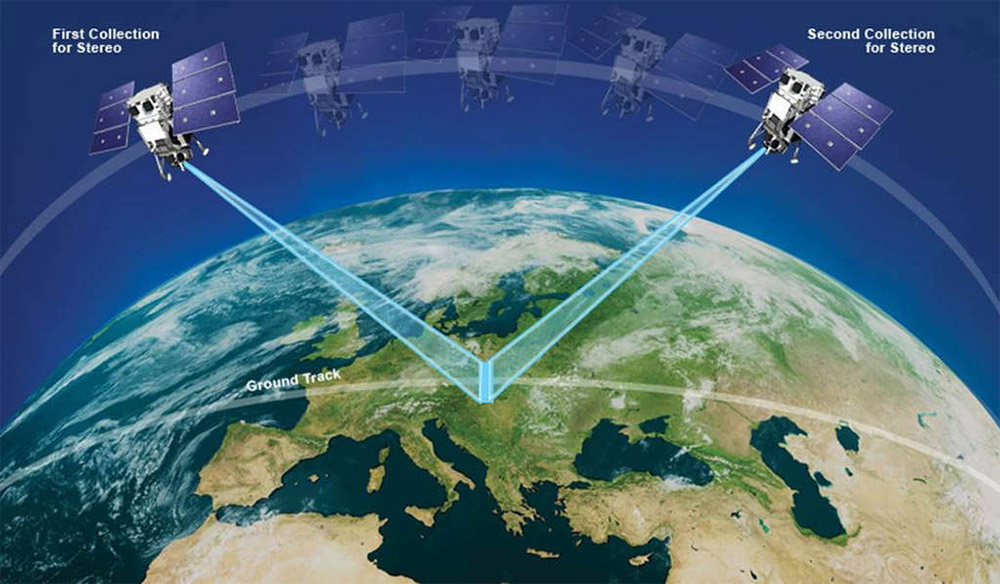In this guide
Introduction to Stereoscopic Imagery
Last Updated: October 4, 2023
Explore the differences between monoscopic and stereoscopic satellite imagery.
Collection Mode
Stereoscopic imagery collection mode refers to when the satellite sensor acquires two images of the same location taken from different angles.
In the case of Maxar’s stereoscopic imagery, the images are taken by the same satellite about 45-90 seconds apart.
The satellite takes a shot of the location of interest, then continues traveling along its orbit for a short time, then rotates the camera to point back towards the same location to collect the second image. This is called in-track stereo.
A stereoscopic pair can also be acquired in cross-track stereo mode when the satellite completes at least one orbit between the two image collections.
In-track stereo is more valuable because less will have changed in the target location between the two shots.
All Maxar satellites can collect imagery in stereoscopic mode. However, due to sensor model uncertainty, the best DEMs are created (more on this later) from stereoscopic imagery collected by WorldView-1, WorldView-2, and WorldView-3.
Related Guide: MAXAR Satellite Constellation

2D to 3D
Using photogrammetric techniques, a pair of imagery shots collected in stereo mode can produce a 3D elevation model of the area.
Digital Elevation Model (DEM) extraction algorithms first perform a method of image matching on the two images in the stereoscopic pair to identify homologous features in both images.
Instead of matching just a few distinctive features, the algorithms attempt to match each pixel with its corresponding pixel from the other image. Because of the slightly different collection geometry and the resulting distortion, any two homologous points on a pair of images will be in slightly different places.
The DEM extraction algorithms use the disparity between the two point locations in combination with the image collection geometry to determine the exact distance from that point to the satellite.
Because the position of the satellite is also precisely known, the the algorithm can calculate the point’s exact horizontal (x,y) and vertical (z) location.
This process of converting matched pixels into geographic coordinates is then calculated over the entire extent of the image pair.
Next, the algorithm interpolates a surface to match the point cloud (collection of matched points), divides the resulting surface into an regularly spaced grid, and writes the output as a raster (gridded) DEM.
The resulting DEM is referred to as a stereo-derived elevation model.
PGC Elevation Models
PGC provides stereo-derived elevation models products at 2 meters per pixel resolution or a reduced 8 meter resolution.
The ArcticDEM project, for example, produces both strip and mosaic DEMs.
Strip Elevation Models
The most common product is the DEM strip, which is the result of running elevation extraction on a set of images all taken in sequence. The strips are 15-17 km wide and 15-100 km long (i.e. the same extent as the source imagery pairs).
A key attribute of the strips is that they have a specific timestamp. Their source images were all collected within a short period, and the strip DEM reflects the state of the terrain at that time.
Another strip DEM taken a year later over the same location would show if there had been any significant elevation changes in the area in the intervening time.
Mosaic Elevation Models
PGC also releases mosaics of the DEM strips. These products cover a larger area, but no longer preserve the unique timestamped nature of the strips.
A mosaic might be made from source DEMs spanning five years, for example.
In order to avoid abrupt discontinuities in elevation values, the source DEMs are co-registered and the edges are blended to create the effect of a single, continuous elevation model.
Detailed specifications on the processing algorithms and PGC’s DEM data products will be covered in the next few guides.
Summary
In this Guide, we’ve covered:
- How satellites collect imagery in stereo mode
- Photogrammetry techniques turn 2D images into elevation
- PGC offers both strip and mosaic stereo-derived DEMs

